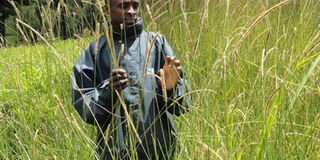Step-by-step guide to farm Rhodes grass

Christopher Chepkarwa at his farm in Keiyo South. PHOTO| SARAH OOKO|NMG.
What you need to know:
- One challenge with Rhodes grass is its poor germination rate, making seeds and planting important issues for a farmer to plan for maximum benefits from this livestock delicacy.
- There are several varieties of Rhodes grass with few differences such as ecological (its relationship with other varieties and also with the environment) preferences, the productivity levels and the ability to withstand grazing at the establishment period. Furthermore, there are also a number of methods that one can use to plant Rhodes grass.
Rhodes grass is a robust drought-tolerant grass with a strong root system that enables it to spread quickly to form a ground cover.
This favourable characteristic combined with its ability to grow in a wide range of conditions, high palatability, ability to be utilised in many ways such as hay, cut-and-carry, grazing and its seed production qualities that makes on-farm seed production possible endear it to many farmers.
One challenge with Rhodes grass, however, is its poor germination rate, making seeds and planting important issues for a farmer to plan for maximum benefits from this livestock delicacy.
There are several varieties of Rhodes grass with few differences such as ecological (its relationship with other varieties and also with the environment) preferences, the productivity levels and the ability to withstand grazing at the establishment period. Furthermore, there are also a number of methods that one can use to plant Rhodes grass.
Varieties of Rhodes grass
Those common in the country include Boma, X-Tozi, Elmba, Mbarara and Masaba.
Boma: This drought-tolerant perennial grass that grows up to 90cm high and is very good for hay production is the most common in the country. Moisture requirement is 600-850mm, and does not tolerate acidic soils. It prefers loose textured loam soil of volcanic origin. It prefers pure stand (grown on its own), but it can also be under sown with oat or maize. Propagation is normally by use of seeds, but stolons (creeping stems that have nodes that have the ability to develop roots) and root splits can be used on small plots. It reaches maturity for grazing at 4-6 months after planting and its highest production is in the second year.
It produces up to 300 hay bales/acre with cutting intervals of 6-8 weeks and produces good quality hay at early flowering stage. Seeds are available from leading producers in the country and after the first batch, one can subsequently make their own seeds from this lot. Up to 350kg/ha is achievable.
X-Tozi: The grass was introduced in the semi-arid coastal areas in 1984. It has since spread to other moisture stress parts of the country that include Makueni, Kwale, Tana River, Kilifi and Lamu. It is a perennial plant that grows to a height of 30-150cm. It spreads through stolons and runners. It prefers sandy/loam soils of volcanic origin. The seeds germinate easily but they are fluffy and hence difficult to handle. Moisture requirement is 600-2,000mm per year. Seeds and cuttings are available at Kalro offices of Mariakani, Mtwapa, Kiboko and Msabaha. The grass grows in all arid and semi-arid areas of the country.
Elmba: The grass has a high seeding vigour and forage production. It is suitable for a wide range of climatic conditions, but does best in sandy soils. It does better at attitudes of 1,200–1,850m above sea level and moisture of 1,000–2,500mm. It has a high growth rate suitable for intensive grazing.
Mbarara and Masaba: Mbarara was introduced from Uganda. It is somehow stemmy, very productive and gives high seed yield with good vigour. Masaba is leafy and productive but the seeds are affected by Smut, a fungi disease that affects the seeds, leaves, stems and flower parts to form a sootlike mass.
Planting practices
The East African Dairy Development Programme (EADD) agricultural initiative has a well-documented pasture establishment. The methods include direct sowing, under-sowing or over-sowing.
Direct sowing
Direct sowing is establishing pasture grasses as pure stands without a nurse or cover crop.
Seedbed preparation: On previously cropped land, plough towards the end of the preceding rainy season. Follow with dry-season ploughing and harrowing for weed control. On virgin land, three ploughings and two harrowings may be required to make a good seedbed.
Sowing time and method: Sow as early as possible in the rainy season. In areas that receive bimodal rainfall, sow during the short rains. This timing has the advantages of eliminating annual weeds and also guaranteeing harvesting for hay making in a dry period.
Sow seeds close to the surface (not more than 2cm) to get them in contact with moist soil so that they will absorb moisture and germinate.
Either broadcast grass seeds or drill in rows 30–40cm apart.
Mix the seeds with sawdust, rough sand or phosphate fertiliser for even distribution. If the seed is mixed with fertiliser, plant immediately to prevent the fertiliser from scorching the seed.
Grass seeds are most effectively sown with a wheat drill and hand sowing is recommended for small acreages.
Immediately after sowing, compact the seedbed to enhance germination of the grass seed by improving contact with the soil. Use tree branches or trample by foot on small plots. In mechanised farms, use a roller. The seeds germinate in 1-7 days.
Fertiliser application at planting: Apply phosphate fertiliser or farmyard manure to promote strong root development. The recommended rates of fertiliser application are as follows:
Single super phosphate (SSP) 2–4 bags/ha or
Triple super phosphate (TSP) 1–2 bags/ha or
Diammonium Phosphate (DAP) 1–2 bags/ha or10 t/ha of farmyard manure should be broadcasted and harrowed in before planting
Top-dress with five bags calcium ammonium nitrate (CAN)/ha or 5 tonnes farmyard manure/ha per year.
To prevent scorching the seed, use DAP only when rainfall is adequate, and use only well-decomposed farmyard manure.
Weeding and seed requirement: During establishment, weeding can be by manual uprooting of weeds but, thereafter, slashing during harvesting will control weeds. Seed rates is 2kg/acre and for propagation through root splits, use 2-3 splits per hole with a spacing of 50cm between plants and 50cm between rows.
Under-sowing
Under-sowing is establishing pastures under a nurse or a cover crop. The nurse crop is grown together with pasture for economical land use. The nurse is harvested after maturity and the pasture left for 2 to 3 years. For successful under-sowing observe the following:
Broadcast or drill pasture seed mixed with fertiliser three days after planting wheat or barley.
Where maize is the nurse crop, broadcast pasture seed mixed with phosphate fertiliser in the maize field after the second weeding of maize (4 to 5 weeks after planting maize) or when maize is knee high.
After the nurse crop is harvested, remove stovers or straws and cut back the weeds using a panga or slasher.
During the establishment year, grazing is not recommended to avoid grass still with weak roots being uprooted by the livestock. If it must be grazed, then use the calves.
Over-sowing
Over-sowing is the introduction of improved pasture species (grasses or legumes) to a natural pasture. Over-sowing increases forage quality and productivity of natural pastures. It is the easiest and most cost-efficient strategy for improving natural pasture. Although both grasses and legumes may be over-sown, legumes are more suitable, as grasses do not establish readily, especially on soils that are not loose.
Over-sowing should be done in areas where soils are light and loose. Benefits become evident after about two years. The advantages of over-sowing include minimal land preparation, less seed and labour, minimal management, controlled soil erosion resulting in improved soil fertility and forage output.
As shown in table above, assuming that the land belongs to the farmer (not leased) and it was also on crop in the previous season, a quick estimate on cost/benefit analysis of Rhodes hay and seed production using the direct s0wing method will be as calculated.
Note that the profit for hay is likely to double in the second year as the grass is well established. Further, ploughing and planting costs are also absent thus tripling the profit.
Talk to Dr Mwirigi on [email protected]




